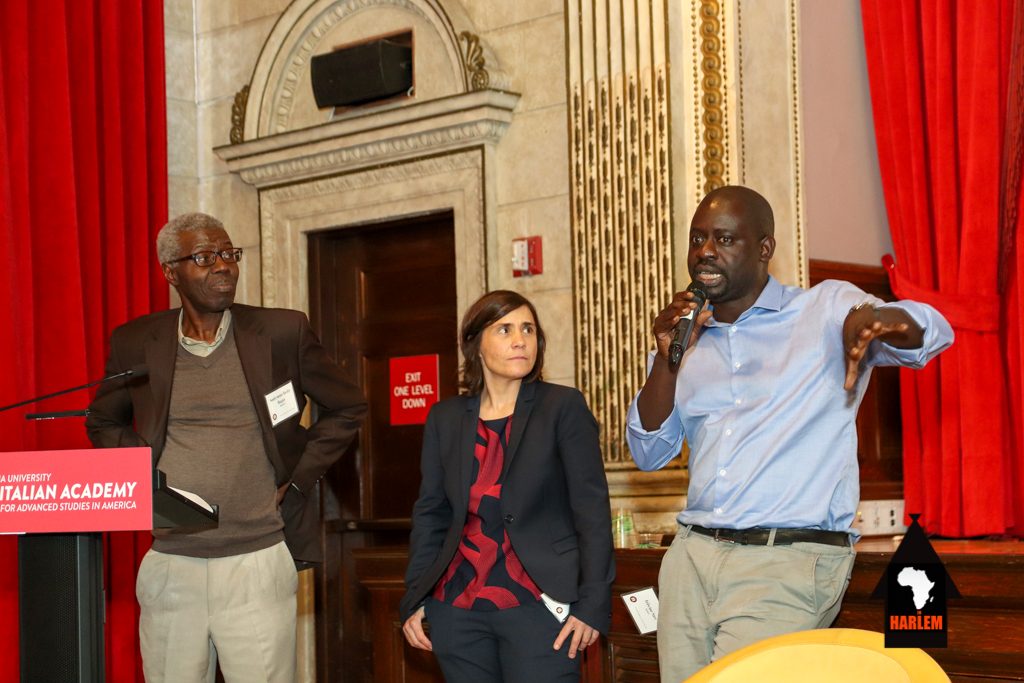African Art in a Global Society
The Restitution Debate

By Alexandra Oduber, GSB 2020
During this international symposium, The Restitution Debate: African Art in a Global Society, I had the opportunity of listening to Felwine Sarr and Bénédicte Savoy reflect on their report, The Restitution of African Cultural Heritage: Toward a New Relational Ethics. After they presented their report on November 2018, I actually wrote an article responding to it so this opportunity of being able to be in the same room listening to these two authors provide updated feedback on this same report, was a pretty surreal experience.
My biggest takeaways came from Felwine Sarr’s and Ugochukwu-Smooth C. Nzewi’s presentations. What I liked a lot about both presentations is that they focused on the intangible and imaginary resources that are lost with these African artifacts in question. Sarr, for instance, mentioned how restitutions are a way for young Africans to insert themselves in a life of creation. Until these artifacts are returned, young Africans will always be missing their historic sense of resilience. Life is born from the memory of one’s culture and history, so the fact that these Western museums have control over these African artifacts just perpetuates colonialism by not allowing young Africans to control and determine their own heritage. This is why I really liked that Sarr does not consider monetary reparations to be sufficient for the damages that come from African art being looted, because he understands that this kind of loss cannot be quantified because it is not only the artifact that is lost, but African societies, culture, and history that were also lost. Economically there is no way to evaluate the loss of African heritage without perpetuating colonialism. Smooth understands this and this is why I also really liked that he brought up the question of: Should the focus be on the physical objects or in the intangible culture and heritage that accompanied these artifacts? Smooth mentioned how the absence of these objects removes the link between the past and present and that this is why a good starting point to find a solution should be for members of Academia to create a research pipeline where they bring great people from the African continent and diaspora to help solve this issue, because Academia is still very white-ruled and should start thinking of ways to start returning the intangible cultures at least.
Overall, the symposium was very focused on the many ways that this issue concerns young members of the diaspora and small steps we can take to fighting colonialism in museums and other institutions.
Image Credits
Africa in Harlem NYC (2019). Images from left to right: Souleymane Bachir Diagne, Bénédicte Savoy, and Felwine Sarr. [image] Available at: https://africainharlem.nyc/en/restitution-of-looted-african-art-by-former-colonizers-discussed-at-conference-in-harlem/#gallery/237c54078cd63de7ddddccfaa194f9d9/53781 [Accessed 26 Nov. 2019].
Africa in Harlem NYC (2019). Souleymane Bachir Diagne and Ugochukwu-Smooth C. Nzewi. [image] Available at: https://africainharlem.nyc/en/restitution-of-looted-african-art-by-former-colonizers-discussed-at-conference-in-harlem/#gallery/237c54078cd63de7ddddccfaa194f9d9/53797 [Accessed 26 Nov. 2019].
This article was originally published in Medium as “Politics on Art: The Repatriation of Sub-Saharan Africa’s Culture Until around 1960, colonization…” Link: https://link.medium.com/
It was re-published on Art Ramblings with the permission of the author [11/26/2019]
More about the author:
Alexandra Oduber is a Panamanian senior at Fordham University’s Gabelli School of Business majoring in Business Administration with a primary concentration in Marketing, a secondary one in Digital Media and Technology, and a minor in Art History. She is interested in writing about contemporary art and its intersection with culture, technology, and digital trends. She wrote this piece in her Professor Caitlin Beach‘s course, Art and the Black Atlantic (ARHI 2525)

